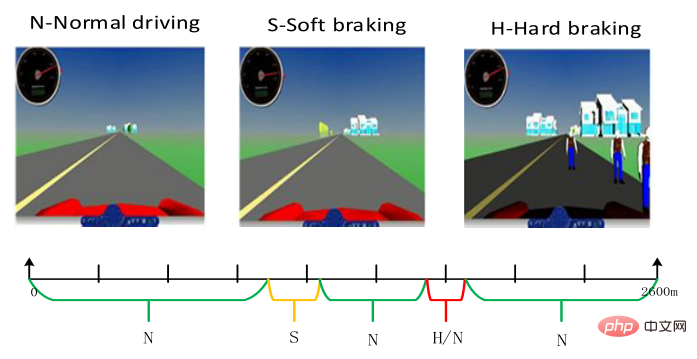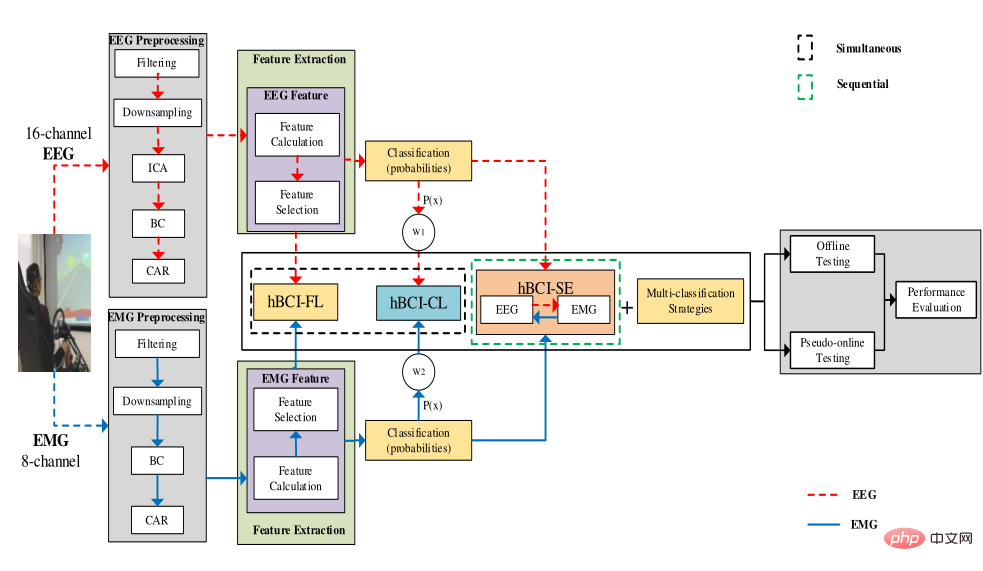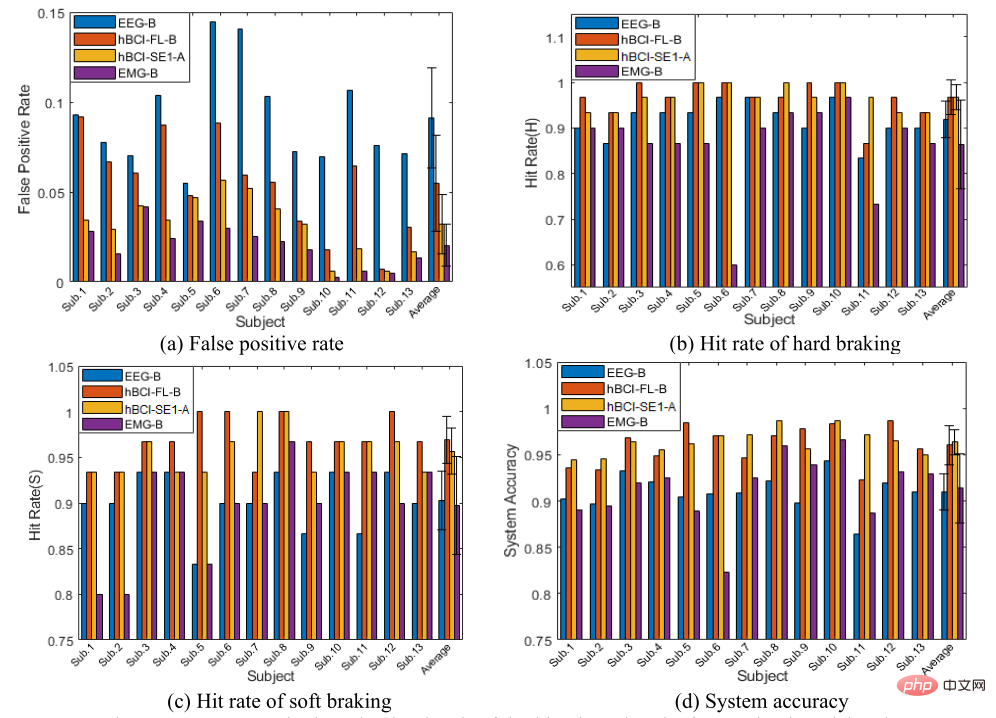 Technology peripherals
Technology peripherals
 AI
AI
 The driver's 'divine assist” on the road! BIT develops hybrid brain-computer interface driving assistance system to improve driving safety
The driver's 'divine assist” on the road! BIT develops hybrid brain-computer interface driving assistance system to improve driving safety
The driver's 'divine assist” on the road! BIT develops hybrid brain-computer interface driving assistance system to improve driving safety
With the improvement of people’s living standards, cars have entered thousands of households. However, while vehicles provide travel convenience, traffic accidents have also become an important threat to the life safety of drivers and pedestrians.
According to incomplete statistics from the World Health Organization in 2018, road traffic accidents are one of the important factors causing casualties and economic losses. Traffic accidents cause nearly 1.35 million deaths and 20-50 million injuries every year. Nearly 3% of the GDP is consumed by traffic accidents every year.
Among them, fatigue driving is an important factor causing traffic accidents, second only to speeding. Therefore, driving safety is no small matter, even if you are an "experienced driver".
Based on driving safety issues, recently, Assistant Professor Luo Longxi and doctoral student Ju Jiawei from the intelligent human-machine system team of Professor Bi Luzheng from the School of Mechanical and Vehicle Engineering of Beijing Institute of Technology proposed a method Intelligent Driving Assistance Systems (IDAS), or synchronized sequential hybrid brain-computer interfaces (hBCIs), combine electroencephalography (EEG) and electromyography (EMG) signals to classify the driver's braking and normal driving intentions.
To put it simply and crudely, this intelligent assistance system can indirectly affect vehicle control by identifying emergencies that the driver may encounter, or it can directly control the vehicle after discovering the emergency. Effectively improve driving safety.
The research was published in the form of a paper in the English science and technology journal Cyborg and Bionic Systems.

Hybrid brain-computer interface——hBCI
Currently, the input information of IDAS mainly includes vehicles Information related to environment, behavior, and biological signals. Vehicle and surrounding environment information mainly comes from vehicle parameters and traffic information. Some IDAS need to detect the driver's drowsiness state, while other systems rely on driving behavior detection and driving intention prediction.
So where does the driver’s relevant information come from? The answer is obtained by monitoring the activity of the driver's feet, limbs and nerves.
Sources of biological information include electroencephalography (EEG) signals and electromyography (EMG) signals. Due to the early emergence of EEG signals, brain-computer interfaces (BCIs) based on EEG signals have been used in driving behavior research. Although these EEG interfaces have made great progress in braking intention detection, their detection performance is not stable due to the characteristics of the EEG signal itself. As an effective solution, hybrid brain-computer interface (hBCI) can solve the shortcomings of EEG-based BCIs such as low stability, poor performance, and insufficient reliability.
Based on how signals are combined, hbci can be divided into two modes, using feature-level fusion strategy (hBCI-FL) and classifier-level fusion strategy (hbci-cl). The first mode combines two or more EEG signals, and the other mode combines EEG with other signals such as EMG signals and ECG signals.
The researchers invited 13 subjects aged between 24 and 30 to participate in the experiment. By collecting EEG signals, EMG signals and vehicle information during simulated driving, the detection of driver's hard braking intention in virtual driving scenarios was studied. Then, they used the hBCI model that combines EEG signals, EMG signals, and vehicle information to detect the upcoming emergency braking intention.

Three driving intention classifications
In the experiment, the R&D team compared and analyzed several simultaneous The sexual and temporal hBCI models use spectral features and temporal features respectively, as well as one VS rest or decision tree classification strategies to perform multiple classifications of the three driving intentions.

The "one VS rest" classification strategy decomposes the three categories into three parallel binary classifications, including normal driving vs. other, soft braking vs. other, and hard braking vs. other. For the one VS rest classification strategy, the final result is obtained based on the maximum value of all two classifiers.
Experimental results show that the R&D team’s hBCI system recognizes hard braking intentions 130 m/s faster than the model based on pedal deflection. The hBCI-SE1 classification algorithm and one-on-one classification strategy based on spectral features have the highest classification accuracy, and the average system accuracy is 96.37%. Finally, the team selected optimal order hBCI, optimal order hBCI and models based on single brain electrical signals or electromyographic signals for comparison.

The results show that optimal simultaneity and sequential hbci are significantly better than those based on single EEG or EMG signal method. In the test, the results obtained were in good agreement with the offline test results.
This research has certain reference value for human-centered intelligent assisted driving systems to improve driving safety and driving comfort. However, the project currently has certain limitations. For example, there are various stimulus factors that induce hard braking and soft braking, the impact of subject differences, the inconvenience of the collection device, etc. Next, the team will solve the above limitations and explore more effective feature and strategy fusion to improve performance.
This research was partially funded by the National Natural Science Foundation of China (51975052) and the Beijing Natural Science Foundation of China (3222021).
Paper address:
https://downloads.spj.sciencemag.org/cbsystems/aip/9847652.pdf
The above is the detailed content of The driver's 'divine assist” on the road! BIT develops hybrid brain-computer interface driving assistance system to improve driving safety. For more information, please follow other related articles on the PHP Chinese website!

Hot AI Tools

Undresser.AI Undress
AI-powered app for creating realistic nude photos

AI Clothes Remover
Online AI tool for removing clothes from photos.

Undress AI Tool
Undress images for free

Clothoff.io
AI clothes remover

AI Hentai Generator
Generate AI Hentai for free.

Hot Article

Hot Tools

Notepad++7.3.1
Easy-to-use and free code editor

SublimeText3 Chinese version
Chinese version, very easy to use

Zend Studio 13.0.1
Powerful PHP integrated development environment

Dreamweaver CS6
Visual web development tools

SublimeText3 Mac version
God-level code editing software (SublimeText3)

Hot Topics
 1378
1378
 52
52
 Smart App Control on Windows 11: How to turn it on or off
Jun 06, 2023 pm 11:10 PM
Smart App Control on Windows 11: How to turn it on or off
Jun 06, 2023 pm 11:10 PM
Intelligent App Control is a very useful tool in Windows 11 that helps protect your PC from unauthorized apps that can damage your data, such as ransomware or spyware. This article explains what Smart App Control is, how it works, and how to turn it on or off in Windows 11. What is Smart App Control in Windows 11? Smart App Control (SAC) is a new security feature introduced in the Windows 1122H2 update. It works with Microsoft Defender or third-party antivirus software to block potentially unnecessary apps that can slow down your device, display unexpected ads, or perform other unexpected actions. Smart application
 The facial features are flying around, opening the mouth, staring, and raising eyebrows, AI can imitate them perfectly, making it impossible to prevent video scams
Dec 14, 2023 pm 11:30 PM
The facial features are flying around, opening the mouth, staring, and raising eyebrows, AI can imitate them perfectly, making it impossible to prevent video scams
Dec 14, 2023 pm 11:30 PM
With such a powerful AI imitation ability, it is really impossible to prevent it. It is completely impossible to prevent it. Has the development of AI reached this level now? Your front foot makes your facial features fly, and on your back foot, the exact same expression is reproduced. Staring, raising eyebrows, pouting, no matter how exaggerated the expression is, it is all imitated perfectly. Increase the difficulty, raise the eyebrows higher, open the eyes wider, and even the mouth shape is crooked, and the virtual character avatar can perfectly reproduce the expression. When you adjust the parameters on the left, the virtual avatar on the right will also change its movements accordingly to give a close-up of the mouth and eyes. The imitation cannot be said to be exactly the same, but the expression is exactly the same (far right). The research comes from institutions such as the Technical University of Munich, which proposes GaussianAvatars, which
 MotionLM: Language modeling technology for multi-agent motion prediction
Oct 13, 2023 pm 12:09 PM
MotionLM: Language modeling technology for multi-agent motion prediction
Oct 13, 2023 pm 12:09 PM
This article is reprinted with permission from the Autonomous Driving Heart public account. Please contact the source for reprinting. Original title: MotionLM: Multi-Agent Motion Forecasting as Language Modeling Paper link: https://arxiv.org/pdf/2309.16534.pdf Author affiliation: Waymo Conference: ICCV2023 Paper idea: For autonomous vehicle safety planning, reliably predict the future behavior of road agents is crucial. This study represents continuous trajectories as sequences of discrete motion tokens and treats multi-agent motion prediction as a language modeling task. The model we propose, MotionLM, has the following advantages: First
 Do you know that programmers will be in decline in a few years?
Nov 08, 2023 am 11:17 AM
Do you know that programmers will be in decline in a few years?
Nov 08, 2023 am 11:17 AM
"ComputerWorld" magazine once wrote an article saying that "programming will disappear by 1960" because IBM developed a new language FORTRAN, which allows engineers to write the mathematical formulas they need and then submit them. Give the computer a run, so programming ends. A few years later, we heard a new saying: any business person can use business terms to describe their problems and tell the computer what to do. Using this programming language called COBOL, companies no longer need programmers. . Later, it is said that IBM developed a new programming language called RPG that allows employees to fill in forms and generate reports, so most of the company's programming needs can be completed through it.
 GR-1 Fourier Intelligent Universal Humanoid Robot is about to start pre-sale!
Sep 27, 2023 pm 08:41 PM
GR-1 Fourier Intelligent Universal Humanoid Robot is about to start pre-sale!
Sep 27, 2023 pm 08:41 PM
The humanoid robot is 1.65 meters tall, weighs 55 kilograms, and has 44 degrees of freedom in its body. It can walk quickly, avoid obstacles quickly, climb steadily up and down slopes, and resist impact interference. You can now take it home! Fourier Intelligence's universal humanoid robot GR-1 has started pre-sale. Robot Lecture Hall Fourier Intelligence's Fourier GR-1 universal humanoid robot has now opened for pre-sale. GR-1 has a highly bionic trunk configuration and anthropomorphic motion control. The whole body has 44 degrees of freedom. It has the ability to walk, avoid obstacles, cross obstacles, go up and down slopes, resist interference, and adapt to different road surfaces. It is a general artificial intelligence system. Ideal carrier. Official website pre-sale page: www.fftai.cn/order#FourierGR-1# Fourier Intelligence needs to be rewritten.
 Huawei will launch the Xuanji sensing system in the field of smart wearables, which can assess the user's emotional state based on heart rate
Aug 29, 2024 pm 03:30 PM
Huawei will launch the Xuanji sensing system in the field of smart wearables, which can assess the user's emotional state based on heart rate
Aug 29, 2024 pm 03:30 PM
Recently, Huawei announced that it will launch a new smart wearable product equipped with Xuanji sensing system in September, which is expected to be Huawei's latest smart watch. This new product will integrate advanced emotional health monitoring functions. The Xuanji Perception System provides users with a comprehensive health assessment with its six characteristics - accuracy, comprehensiveness, speed, flexibility, openness and scalability. The system uses a super-sensing module and optimizes the multi-channel optical path architecture technology, which greatly improves the monitoring accuracy of basic indicators such as heart rate, blood oxygen and respiration rate. In addition, the Xuanji Sensing System has also expanded the research on emotional states based on heart rate data. It is not limited to physiological indicators, but can also evaluate the user's emotional state and stress level. It supports the monitoring of more than 60 sports health indicators, covering cardiovascular, respiratory, neurological, endocrine,
 What are the effective methods and common Base methods for pedestrian trajectory prediction? Top conference papers sharing!
Oct 17, 2023 am 11:13 AM
What are the effective methods and common Base methods for pedestrian trajectory prediction? Top conference papers sharing!
Oct 17, 2023 am 11:13 AM
Trajectory prediction has been gaining momentum in the past two years, but most of it focuses on the direction of vehicle trajectory prediction. Today, Autonomous Driving Heart will share with you the algorithm for pedestrian trajectory prediction on NeurIPS - SHENet. In restricted scenes, human movement patterns are usually To a certain extent, it conforms to limited rules. Based on this assumption, SHENet predicts a person's future trajectory by learning implicit scene rules. The article has been authorized to be original by Autonomous Driving Heart! The author's personal understanding is that currently predicting a person's future trajectory is still a challenging problem due to the randomness and subjectivity of human movement. However, human movement patterns in constrained scenes often vary due to scene constraints (such as floor plans, roads, and obstacles) and human-to-human or human-to-object interactivity.
 Read the smart car skateboard chassis in one article
May 24, 2023 pm 12:01 PM
Read the smart car skateboard chassis in one article
May 24, 2023 pm 12:01 PM
01 What is a skateboard chassis? The so-called skateboard chassis integrates the battery, electric transmission system, suspension, brakes and other components on the chassis in advance to achieve separation of the body and chassis and decoupling the design. Based on this type of platform, car companies can significantly reduce early R&D and testing costs, while quickly responding to market demand to create different models. Especially in the era of driverless driving, the layout of the car is no longer centered on driving, but will focus on space attributes. The skateboard-type chassis can provide more possibilities for the development of the upper cabin. As shown in the picture above, of course when we look at the skateboard chassis, we should not be framed by the first impression of "Oh, it is a non-load-bearing body" when we come up. There were no electric cars back then, so there were no battery packs worth hundreds of kilograms, no steering-by-wire system that could eliminate the steering column, and no brake-by-wire system.



